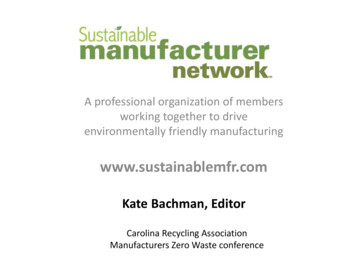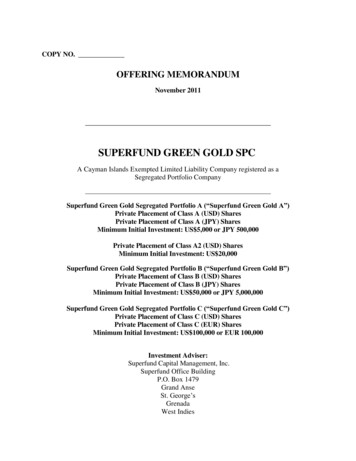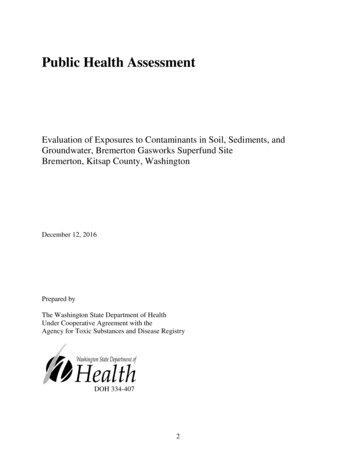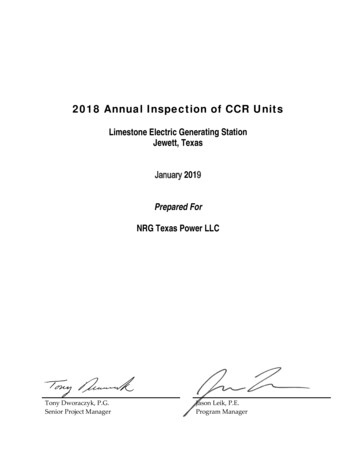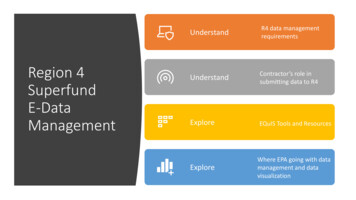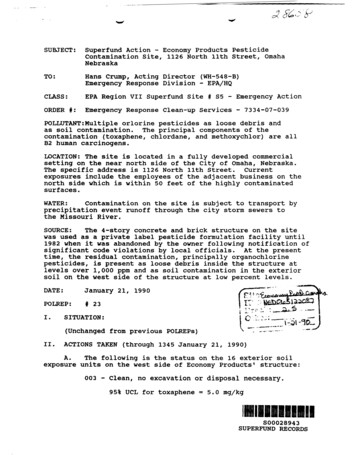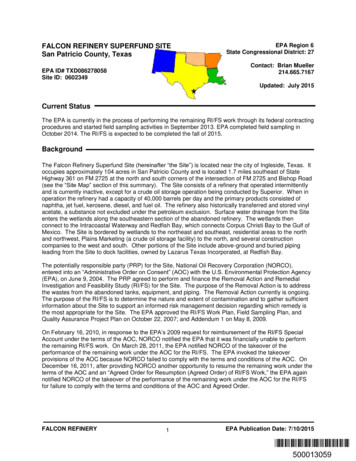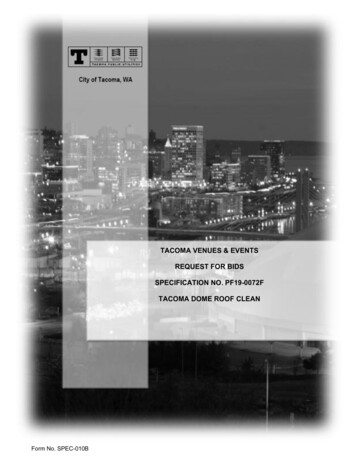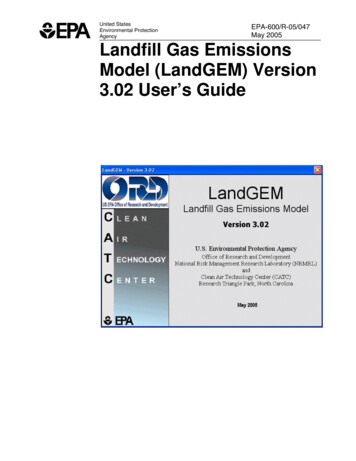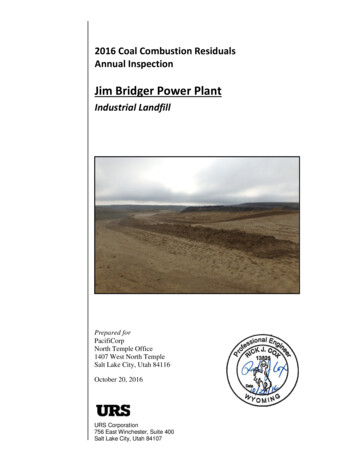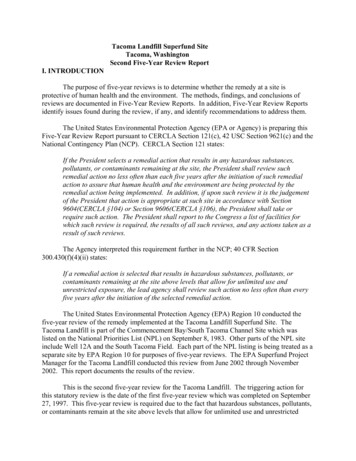
Transcription
Tacoma Landfill Superfund SiteTacoma, WashingtonSecond Five-Year Review ReportI. INTRODUCTIONThe purpose of five-year reviews is to determine whether the remedy at a site isprotective of human health and the environment. The methods, findings, and conclusions ofreviews are documented in Five-Year Review Reports. In addition, Five-Year Review Reportsidentify issues found during the review, if any, and identify recommendations to address them.The United States Environmental Protection Agency (EPA or Agency) is preparing thisFive-Year Review Report pursuant to CERCLA Section 121(c), 42 USC Section 9621(c) and theNational Contingency Plan (NCP). CERCLA Section 121 states:If the President selects a remedial action that results in any hazardous substances,pollutants, or contaminants remaining at the site, the President shall review suchremedial action no less often than each five years after the initiation of such remedialaction to assure that human health and the environment are being protected by theremedial action being implemented. In addition, if upon such review it is the judgementof the President that action is appropriate at such site in accordance with Section9604(CERCLA §104) or Section 9606(CERCLA §106), the President shall take orrequire such action. The President shall report to the Congress a list of facilities forwhich such review is required, the results of all such reviews, and any actions taken as aresult of such reviews.The Agency interpreted this requirement further in the NCP; 40 CFR Section300.430(f)(4)(ii) states:If a remedial action is selected that results in hazardous substances, pollutants, orcontaminants remaining at the site above levels that allow for unlimited use andunrestricted exposure, the lead agency shall review such action no less often than everyfive years after the initiation of the selected remedial action.The United States Environmental Protection Agency (EPA) Region 10 conducted thefive-year review of the remedy implemented at the Tacoma Landfill Superfund Site. TheTacoma Landfill is part of the Commencement Bay/South Tacoma Channel Site which waslisted on the National Priorities List (NPL) on September 8, 1983. Other parts of the NPL siteinclude Well 12A and the South Tacoma Field. Each part of the NPL listing is being treated as aseparate site by EPA Region 10 for purposes of five-year reviews. The EPA Superfund ProjectManager for the Tacoma Landfill conducted this review from June 2002 through November2002. This report documents the results of the review.This is the second five-year review for the Tacoma Landfill. The triggering action forthis statutory review is the date of the first five-year review which was completed on September27, 1997. This five-year review is required due to the fact that hazardous substances, pollutants,or contaminants remain at the site above levels that allow for unlimited use and unrestricted
exposure.The information used to conduct this review is contained in the Site File for the TacomaLandfill site. The primary documents used in the review consist of the following:1. Tacoma Landfill Consent Decree - May 1991.2. Tacoma Landfill Operations and Closure Plan - revised January 1998.3. Consent Decree 2001 Annual Report - May 2002.4. Annual Summary of Inspections for the Tacoma Landfill Cap, Condensate CollectionSystem and Central Area Leachate Collection System - May 2002.5. Tacoma Landfill Biannual Gas System Evaluation Reports - July 1, 2001 through June30, 2002.6. Tacoma Landfill Odor Control Plan - September 30, 1998.7. Tacoma Landfill Bird Management Plan - March 2002.8. Tacoma Landfill Five Year Review Report - September 19, 1997.9. Letter from EPA to Tacoma dated May 11, 1998, which extended landfilling activitiesat the site for 5 additional years.10. Comment letters received from the public in response to the EPA fact sheetadvertising the Review.11. Correspondence from the Tacoma-Pierce County Health Department in response toEPA’s request for information.Additional information was obtained during a site inspection of the Landfill conducted onSeptember 12, 2002.II. SITE CHRONOLOGYEventTacoma Landfill begins operationInvestigation detects hazardous substances in groundwater & soils near siteLandfill placed on the National Priorities ListLandfill gases cause small explosion at a neighboring businessTacoma begins RI/FS pursuant to Consent Order with the StateRI/FS completedEPA issues RODConsent Decree finalized between Tacoma, Washington StateDept. of Ecology (Ecology), and EPALandfill cap & gas management system construction completedGroundwater pump & treat system construction completedFirst Five-Year Review completedTacoma’s request to extend waste disposal activities at site approvedGroundwater treatment system turned offExtracted groundwater discharge diverted from sanitary sewer to storm sewerIII. 19951997199819982002
Physical CharacteristicsThe City of Tacoma Refuse Utility operates a solid waste disposal facility known as theTacoma Landfill which is located within the City of Tacoma in Pierce County, Washington.Specifically, the landfill is situated in Sections 12 and 13 of Township 20 North, Range 2 East,near the western border of Tacoma. The landfill covers 240 acres and is bounded approximatelyby South 31st Street on the north, Tyler Street on the east, South 48th Street on the south, andOrchard Street on the west. See Figure 2.Land and Resource UseThe Tacoma Landfill began operations in 1960, and has been operating as a sanitarylandfill under a permit issued by the Tacoma-Pierce County Health Department. The wastesdisposed at the landfill include garbage, rubbish, industrial wastes, construction and demolitionwastes, street refuse, litter, and bulky waste. To date the landfill has received approximately 5million tons of refuse. The landfill does not accept hazardous waste for disposal. However, thelandfill received wastes in the 1960s and 1970s that have since been designated as hazardouswastes under state and federal law. Most of the site has already been filled. The last section ofthe site to be filled is called the Central Area which covers approximately 31 acres. This sectionwas developed in 1987 and continues to be used for waste disposal. The Central Area wasconstructed with a flexible membrane bottom liner and leachate collection system. In addition towaste disposal, the site is the operations center for all solid waste management activities in theCity of Tacoma. Solid wastes transported to the site are segregated, processed, and removedfrom the site with the exception of a small percentage of waste that is disposed in the CentralArea. Figure 3 for a layout of the site.The landfill is surrounded primarily by residential and commercial development withsome open land and industrial development. The site is surrounded by a fence. Groundwateraround the site is currently used as a drinking water aquifer. However, the City of Tacoma hasreplaced all wells affected by contamination from the site with municipal water and the drillingof new wells in the area affected by contamination from the site is currently prohibited by thecities of Tacoma, Fircrest, and University Place. The dominant groundwater flow is to the southand west and towards Leach Creek located approximately 1/2 mile west of the landfill. LeachCreek flows into Chambers Creek which enters into Puget Sound, approximately 5 milessouthwest of the landfill.History of Contamination and Initial ResponseGroundwater contamination, primarily volatile organic compounds, was first detected inthe early 1980s around the perimeter of the landfill and extended in a southwesterly directiontoward Leach Creek. Because of the concern about public health effects of the contamination,particularly vinyl chloride, residents whose wells were impacted or threatened were hooked up tothe Tacoma public water system in the mid-1980s. Landfill gases were found to be migratingfrom the landfill to residences and businesses adjacent to the site. The landfill gases containedmethane, which can cause explosions at certain concentrations, and volatile organic compounds,which can cause negative health effects at elevated concentrations. Because of a concern over
the migration of landfill gases, the first stage of a landfill gas management system wasconstructed in 1986.Basis for Taking ActionMonitoring at the site revealed that hazardous substances had been released from thelandfill into the soils, groundwater, and air at the site. The hazardous substances released togroundwater include a variety of volatile and semi-volatile organic compounds and heavymetals, many of which were greater than State and Federal drinking water standards. Vinylchloride was the most pervasive compound found in groundwater and represented the greatesthealth risk to human health. Landfill gases were found to contain a wide variety of volatileorganic compounds as well as methane. The volatile organic compounds represent a risk tohuman health if the gases seep into neighboring homes and businesses. The methane in the gasesrepresents the greatest risk to human health as it can cause explosions when it accumulates tocertain concentrations. Accumulation of landfill gas in a utility vault at a company locatedadjacent to the landfill resulted in a small explosion in May 1986. Many of the same compoundsfound in groundwater and in landfill gases were also found in soils at the site.The following are the chemicals of concern found in groundwater at the e1,2-Dichloroethenes (total)Vinyl ChlorideBenzeneXylenes hylene ChlorideThe following chemicals were found in landfill gases:MethaneEthyl BenzeneBenzeneMethylene eneVinyl Chloride1,2-DichloropropaneIV. REMEDIAL ACTIONSRemedy SelectionOn March 31, 1988, EPA issued the Record of Decision (ROD) which selected the finalremedial action for the site based on the RI/FS. On November 13, 1989, a Consent Decreebetween EPA, Ecology, and the City of Tacoma was lodged in federal court. The Decree
addressed implementation of the remedial actions specified in the ROD. This Decree was notaccepted by the Court and was subsequently modified. The modified Decree was entered by theCourt on May 17, 1991. The Consent Decree requires a review of the remedial actionsconducted at the site at least every five years after the entry date of the Decree. This Five-YearReview satisfies both the Consent Decree requirement and the statutory requirement for 5-yearreviews.The ROD outlines the final remedial action for the site. The objectives for the remedialaction are as follows:Reduce the production of leachate by placing constraints on further site operations and bycapping the landfill;Eliminate off-site gas migration through the gas extraction system;Prevent further migration of the contaminated plume via a groundwater extractionsystem;Further protect public health and the environment via monitoring of groundwater, surfacewater, gas probes, and air emissions;Provide an alternate water supply (Tacoma municipal water) to any residences deprivedof their domestic supply due to demonstrated contamination from the landfill or due tothe action of the extraction-treatment system;Establish a closure plan for the landfill consistent with Washington State MinimalFunctional Standards for Landfill Closure (WAC 173-304);Establish institutional controls to assure that the remedial action will continue to protecthuman health and the environment.Remedy Implementation, Operation, and MaintenanceThe following remedial measures have been completed:1. A landfill cover was installed over areas containing buried waste in two stages from 1990 to1992 with the exception of the currently operating cell known as the Central Area. The coverwas installed on approximately 125 acres of the 240 acre site. The purpose of the cover is tominimize rainwater and surface water infiltration into the landfill thereby reducing theproduction of leachate which is the source of groundwater contamination. The cover consists oftwo 60 mil HDPE liners separated by a leak detection and water collection layer with theexception of 4 acres which became part of an expanded operations area. The 4 acres werecapped with a geomembrane layer and then covered by buildings or low permeable asphaltpavement. The permeability of the asphalt cover is regularly checked with lysimeters installed5
in the cover. The asphalt cover is also regularly inspected and maintained in accordance with theOperations and Maintenance Plan. The capped areas are regularly inspected and maintained inaccordance with the Operations and Maintenance Plan. The capped areas are inspected forevidence of erosion, settlement, ponding of water, improper or inadequate vegetation, burrowinganimals, cracking, and other parameters as outlined in the Operations and Closure Plan.Active land filling is still occurring in the Central Area which is the only portion of thesite with a bottom liner. The Central Area cell was developed and first used in 1987 and thenexpanded to it’s current 31 acres in 1990. The bottom liner is composed of two liners separatedby a leak detection and water collection system. The side slopes in the Central Area consists of asingle liner which separates the Central Area from the old landfill. As the Central Area is notcovered, leachate is generated by the precipitation that falls onto this area. The Central Area wasconstructed with a leachate collection system which collects leachate and transports it to thesanitary sewer system for treatment and disposal. When the Central Area is eventually filled up,it will be covered with a cover similar to the one installed over the rest of the landfill.While most of the cover has been performing as designed and is meeting performancestandards, water has been found flowing in between the upper and lower landfill covers in anarea on the west side of the landfill after periods of rain. It is not known when the leak in theupper landfill cover developed, but may have been present ever since the landfill cover systemwas installed. Since the water is collected prior to contacting garbage, it is treated as stormwater and is discharged into a catch basin that is connected with the storm sewer system. Nolandfill cover can be completely impermeable and all allow some leakage. The amount ofleakage in the upper cover in this area exceeds the original design criteria. The City has madeseveral attempts to locate and fix the source of the leak over the past 10 years. These efforts arecontinuing.Regular inspections of the landfill cover system by the City of Tacoma reveal evidence ofminor damage such as local subsidence, erosion, ponded water, tears in the geomembrane lineraccidentally caused by landfill operators, and cracks in the asphalt. These problems are normalat active landfills and are corrected by the City during routine maintenance activities.A small amount of leachate is finding its way between the two bottom liners in theCentral Area. This leachate is being collected by the leak detection/collection system andtransported to the sanitary sewer for treatment and disposal. The amount of leachate is notconsidered to be significant and will likely decrease after the final cover system is installed overthe Central Area.2. A landfill gas management system was installed in several phases starting in 1986. Thesystem currently consists of over 300 gas extraction well stations each consisting of 1 to 4 wellscompleted to various depths, piping for transferring the collected gas to a flare station where thegas is destroyed, and the flare station. See Figure 5 for the location of the gas extraction wells.The gas management system is being expanded into the Central Area as an areas get filled tofinal grade. The purpose of the landfill gas management system is to control the migration oflandfill gases. Specifically, the system was designed to meet State of Washington Criteria forMunicipal Solid Waste Landfills which require that methane concentrations must not exceed thelower explosive limit (5% methane by volume) at the property boundary of a landfill and notexceed 100 parts per million in off-site structures. The effectiveness of the landfill gas6
management system is evaluated through regular monitoring of gas probes situated within andadjacent to for pressure (vacuum) and methane concentrations. The gas monitoring systemincludes approximately 75 gas monitoring probes around the perimeter of the landfill and anadditional 55 probes up to 1,000 feet from the edge of the landfill, each probe consisting of 1 to 5monitoring ports completed to various depths. See Figure 4 for the location of the gasmonitoring probes. The landfill gas management system is a dynamic system affected bychanges in the barometric pressure, pressure changes created by the development of landfill gaswithin the landfill and the vacuum applied by the gas collection system. Because of the dynamicnature of the system, some fluctuations of both the pressure and methane readings at the probestations is normal. It is through these fluctuations that the need for adjustments to the gas systemare identified. Changes in pressure alone do not trigger adjustments to the system, because theyare generally temporary in nature and result from changes in the barometric pressure.The City signed a contract in 1995 to lease the landfill gas field to a private company forthe purpose of constructing an electrical generation facility at the landfill. This facility becameoperational in 1998 and is currently utilizing a portion of the collected landfill gases to generateelectricity as opposed to destroying the gases in the existing flares. The flares are still utilized todestroy the gases produced by extraction wells that are not hooked up to the electrical generationfacility. With the exception of the extraction wells hooked up to the electrical generationfacility, the gas extraction system and the gas monitoring system are being operated in the samemanner as previously employed.In 1996 the City discovered that leachate was collecting in some landfill gas extractionwells and was impacting the effectiveness of the landfill gas management system. Further studyfound a fairly extensive zone of leachate in the south end of the capped landfill. The origin ofthis perched leachate is not known, but is believed to be residual leachate created prior toconstruction of the landfill cover. Based on these findings, the City conducted leachate pumptests through the existing gas probes and found that there is a substantial perched zone ofleachate and that the leachate could be pumped out through the gas probes. The City has beenperiodically pumping out this leachate since 1996. The leachate is being pumped out mainly toincrease the efficiency of the gas extraction wells in this area. The leachate is discharged intothe City’s sanitary sewer system for treatment.Methane gas has been detected in a new gas probe installed after construction of a HomeDepot Store on the northern portion of the site. This issue is discussed in greater detail inSection V.1.d. of this report.3. In 1992 and 1993 a groundwater extraction and treatment system (GETS) was constructed.GETS consisted of 19 point-of-compliance (POC) wells (identified as W1 through W19 onFigure 1) and 9 edge-of-plume (EOP) wells (identified as W30 through 38 on Figure 1),pipelines to transport the extracted groundwater to a treatment facility, and a groundwatertreatment system. The POC wells are located on the down gradient edge of the landfill and theirpurpose is to capture contaminated groundwater before it flows outside of the landfill boundary.The EOP wells are located along Leach Creek and their purpose is to cleanup the plume ofcontaminated groundwater at the edge of the plume and prevent the contamination fromimpacting Leach Creek and groundwater beyond the creek. Once extracted from the EOP andPOC wells, groundwater was transported via pipelines to a treatment facility. The treatment7
facility is equipped with: two air strippers to remove the volatile organic compounds; an acidwash system to periodically remove scale buildup from the internal packing material in thetowers; and a control building where overall operations, control and monitoring of thegroundwater extraction/treatment facilities are managed. The treated groundwater was thendischarged to the sanitary sewer system for further treatment and disposal.Based on groundwater monitoring and several years of experience in operating thegroundwater extraction systems, improvements to the systems were made in 1995 through 1997.Monitoring of well yields indicated that some wells in the EOP system were not extracting attheir designed flow rate and that flow from other wells were decreasing. In 1995 and 1996, awell rehabilitation program was conducted to increase the amount of groundwater beingextracted from the EOP wells. Although the well rehabilitation program was successful inincreasing flows from most wells, new wells were needed to increase total flow along the EOPsystem to design yields. In 1996 and 1997 4 new wells (identified as W40 through 43) wereconstructed along the EOP system, primarily in the extreme south end. The total number of EOPwells currently being pumped is 13. Enhancement of the POC system was prompted bygroundwater monitoring data at a monitoring well near the City of Fircrest municipal well field.Groundwater quality data from this well indicated that vinyl chloride concentrations increasedfrom 1991 through 1995 during the summer time when the municipal water needs are high. Inresponse, the POC system was expanded by installing 3 new wells (identified as W 20, 21, & 22)to the north near the Fircrest well. The total number of POC wells currently being pumped is 22.Groundwater monitoring results from 1997 through 2001 are contained in and analyzed in theConsent Decree Annual Reports for those years.Flows from the groundwater extraction wells gradually decrease over time due to growthof natural soil bacteria on the well screens. The City periodically treats the wells to remove thebacteria growth which then allows the wells to increase their extraction rates to design flows.4. Operation of the EOP groundwater extraction system reduces the base flows in Leach Creeksince it removes shallow groundwater that feeds the creek. Until 2002 the City maintained flowsin Leach Creek using water from a well located northwest of the landfill. The augmentation wellbegan operation on June 30, 1993 and was initially operated to maintain a minimum of 1.5 cubicfeet per second (cfs) in Leach Creek as measured at the 40th Street gauging system. Theminimum flow requirement was increased to 1.6 cfs when new EOP extraction wells beganoperation in 1997. The requirements for the Leach Creek augmentation system are contained ina 1996 amendment to the Consent Decree. The source of augmentation water was changed in2002 as discussed in Section V.1.a. of this report. The flows and water quality in Leach Creek issampled each quarter from one location upstream of the landfill and from 2 locations downstream. Monitoring indicates that the Landfill is not significantly impacting the water quality ofLeach Creek and that minimal flow requirements are being met.5. The City of Tacoma is required to provide an alternate water supply to all residents whosewells became or become contaminated by the landfill. The City has connected the affectedresidents to the Tacoma municipal water system. According to the criteria established for this8
site, a well is considered contaminated when the concentration of a chemical exceeds 20% of it’sdrinking water standard or health-based level. Private wells still in use in the vicinity of thelandfill, as well as monitoring wells between the landfill and the private wells, are monitored ona regular basis. Monitoring and contingency plans have been developed to track thecontaminated plume and to respond to a potential expansion of the contaminated plume. SeeFigure 6 for a map of monitoring wells and groundwater flow direction. However, not all of theold wells have been abandoned; some may still be used for outdoor purposes such as lawn orgarden watering. This 5-year review could not determine which residential wells were beingused as sole domestic water supplies and which were being used only for outdoor purposes.Without this information, we could not verify that the system established to replacecontaminated wells is being strictly adhered to. Subsequent to this 5-year review, EPA willrequire the City to obtain and supply us with the information needed to make this determination.In 1995 Tacoma asked the neighboring City of Fircrest to limit the amount of water beingpumped from their municipal well closest to the landfill, Fircrest Well # 5 because of thepotential threat of pulling in landfill contaminants at higher pumping levels. In 1996 Tacomadrilled a new well to replace Fircrest Well #5. The old well has been temporarily closed. TheFircrest wells located closest to the landfill are regularly sampled by the City. Contaminantsfrom the landfill have not been detected in these wells.6. The City began recycling and household hazardous waste collection programs in the mid1980s. The purposes of these programs are to reduce the total volume of waste going into thelandfill and to minimize the amount of hazardous substances going into the landfill. Tacoma’srecycling program includes curb side collection of a variety of materials including glass, cans,plastic bottles, newsprint and other waste paper, and yard waste. Drop off locations have beenestablished for waste oil, household batteries, tires, appliances, and other items containingpotentially hazardous substances. The City also provides assistance to businesses regardingrecycling opportunities and proper procedures for disposing of wastes containing hazardoussubstances.7. The City developed an Institutional Control Plan dated July 17, 1992 which outlinesprocedures to prohibit drilling of water supply wells within and adjacent to the landfill and toprohibit any activity that will negatively impact the remedies constructed at the landfill. ThePlan was conditionally approved by EPA and Ecology on August 17, 1992. The Cities ofTacoma, Fircrest, and University Place have enacted ordinances which prohibit the drilling ofprivate water supply wells within the plume of landfill contamination. The City of Tacoma hasdeveloped covenants which prohibit site activities that may threaten human health and theenvironment or may damage the remedies installed at the Landfill. The City has also developeda long-range plan for site use after closure of the Central Area cell. The long-range plan includescontinued use of a portion of the site for solid waste transfer activities and recreational use of therest of the site when no longer needed for remediation activities. The entire site is currentlysurrounded by a chain link fencing with gates that are locked when the landfill is closed.V. PROGRESS SINCE LAST REVIEW9
1. Previous Five-Year Review - The first 5-year review was completed in September 1997. Thereview concluded that the remedy selected for this site remains protective of human health andthe environment. The following were recommendations made in the review:a. Recommendation: Continue to operate the groundwater extraction and treatment system andmake adjustments and improvements to the system as appropriate. The groundwater extractionsystem has been operating since 1993 and the groundwater monitoring program has shown ageneral improvement in water quality conditions in the contaminated plume outside theboundary of the landfill. New extraction wells were added to the EOP and POC system in 1996and 1997. The EOP and POC wells need regular rehabilitation to remove deposits which reducepumping capacity. Performance of the extraction wells should continue to be monitored throughregular inspection and maintenance and through monitoring of groundwater around the landfill.Improvements and modifications should continue to be made as appropriate.Evaluation of Progress: Because the combined water from all groundwater extraction wells metperformance standards specified in the ROD for discharge into the sanitary sewer system for 6consecutive quarters, the treatment system was mothballed in December 1998. The extractedgroundwater was then discharged into the sanitary sewer system for treatment and disposal.Groundwater quality throughout the plume has continued to improve. By August 2002 thecombined water from all groundwater extraction wells met performance standards specified bythe ROD and by Ecology for discharge to surface water for 4 consecutive quarters. In responsethe City requested to temporarily change the discharge of extracted groundwater from thesanitary sewer system to Leach Creek. EPA and Ecology approved that request after beingassured that the receiving storm sewer has adequate capacity to handle the additional flows.Since last August, the City has been periodically discharging all or a portion of extractedgroundwater to Leach Creek to assist in design of a permanent discharge to the creek. Thedischarge of this water to Leach Creek has resulted in a decreased use of the augmentation well.However, Leach Creek continues to be augmented (through a combination of the discharge fromthe groundwater extraction system and the augmentation well) and monitored to assure thatestablished minimum flow and water quality requirements for the creek are attained. Acontinuous and permanent discharge of extracted groundwater to Leach Cre
4. Annual Summary of Inspections for the Tacoma Landfill Cap, Condensate Collection System and Central Area Leachate Collection System - May 2002. 5. Tacoma Landfill Biannual Gas System Evaluation Reports - July 1, 2001 through June 30, 2002. 6. Tacoma Landfill Odor Control Plan - September 30, 1998. 7. Tacoma Landfill Bird Management Plan .
